Diagnosis - androgenic alopecia. Symptoms and complex treatment
Androgenic alopecia (AGA), like any other alopecia, is still at the stage of study by specialists. Therefore, it is so difficult to find out the reasons and prescribe the proper treatment, although every year more and more people are prone to alopecia. Most often, androgenic alopecia in women is accompanied by a genetic predisposition and a high concentration of the male hormone testosterone. All the same, androgenic alopecia are more susceptible to men, it affects up to 80% of men and up to 50% of women during their life.
Symptoms of androgenic alopecia
Hair loss in androgenic alopecia occurs gradually, increasing with age and leading to baldness of the parietal and frontal regions. How does hair fall out with AGA? Each hair on the head goes through three phases of development: active growth (anagen phase), a resting phase (catagen) and shedding (telogen), and then a return to the anagen phase. With androgenic alopecia, the growth phase (anagen) is shortened several times (in comparison with healthy hair) and very quickly passes into the resting phase and, accordingly, loss. That is, the hair falls out, a new one grows in its place, but already thinner and shorter, since it does not have time to grow and falls out again, then even thinner (like fluff) hair and shorter appear in its place, and this continues until then until the hair follicle atrophies at all.
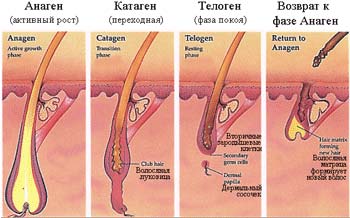
In androgenic alopecia, genetically predisposed hair follicles under the influence of androgenic stimulation tend to miniaturize, as a result of which terminal pigmented hair is replaced with barely noticeable depigmented hair. This leads to a progressive decrease in the density of visible hair on the scalp, depending on the age and gender pattern.
Progressive scheme of androgenic alopecia in women according to the Ludwig scale:
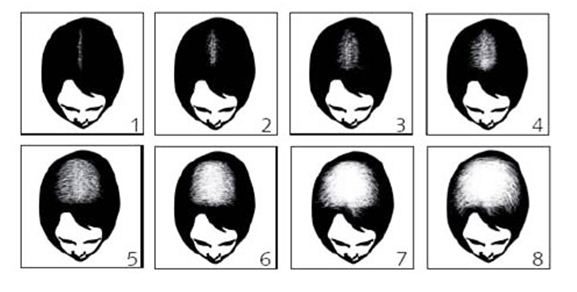 The diagnosis of androgenic alopecia can only be made by a specialist, after a series of tests. The main dermatoscopic signs of androgenic alopecia are:
The diagnosis of androgenic alopecia can only be made by a specialist, after a series of tests. The main dermatoscopic signs of androgenic alopecia are:
Difference in hair diameter - a characteristic diagnostic sign of AGA, affects more than 20% of hair in androgen-dependent zones. Under the influence of androgens, the hair follicles undergo progressive miniaturization, the produced hair gradually becomes thinner and less pigmented. In severe forms of AGA, miniaturization diffusely affects the follicles, and uniform thinning of the hair is observed.
Empty follicle phenomenon characterizes the presence of yellow dots on the scalp, which correspond to empty follicles. The yellow color is due to the fact that the follicular orifices, expanded to a greater or lesser extent, are filled with sebum produced by the sebaceous glands.
Pigmentation is a nonspecific sign of AGA, nevertheless it occurs often, especially in severe forms. This is a reticular, cellular pigmentation of the interfollicular epidermis, clearly visible at 40-50 times magnification. This dark pigmentation is caused by increased sun exposure on the scalp that is not well covered with hair.
Peripillary signs, also called peripillary rings, appear as a dark halo about 1 mm in size around the follicular opening from which the hair emerges. Deloche in 2004 trichoscopically demonstrated the presence of peripillary signs in AGA and their correlation with superficial perifollicular inflammation in this condition.
Inflammation: the scalp of patients with AGA is often (to a greater or lesser extent) erythematous, hyperemia may be diffuse or in the form of foci. In most cases, erythema is caused by inflammation caused by seborrheic dermatitis.At high magnification (40x), erythema corresponds to the dilated vessels of the capillaries of the superficial layers of the dermis, which in seborrheic dermatitis usually form irregular loops.
AGA in women can be early, already in adolescence, or late onset, coinciding with the period of menopause.
Complex therapy in the treatment of androgenic alopecia
Treatment of anrogenic alopecia is very long, one might say lifelong, and this lesson is complex and requires a systematic approach. We will consider those treatments for AGA that are clinically confirmed.
It is not possible to cure androgenic alopecia, you can only slow down this process and keep the hair in a "normal" state.
With androgenic alopecia, traditional medicine is absolutely useless, homemade masks, rubbing in and other grandmother's recipes will not help you with this problem, and sometimes they can even harm you, especially oils that can clog the pores on the scalp and aggravate the situation even more. Try not to smear your scalp with all sorts of folk remedies.
Before taking any medications, it is imperative to consult a doctor.
The drug Minoxidil for AGA
Minoxidil is a hair growth stimulant, although Minoxidil was originally developed to treat hypertension. If with the treatment of arterial hypertension, the effect of the drug is clear for specialists, then its effect on hair growth is still being studied. Minoxidil promotes hair growth by increasing the anagen phase (growth phase), increasing follicular size, and stimulating the growth of resting hair follicles.
Minoxidil in a dosage of 1 ml is applied to dry scalp twice a day (2 or 5%), evenly distributed over the skin of the affected areas and left for at least 4 hours. If the topical application of minoxidil is discontinued, hair loss will begin in 8-12 weeks, thus gradually all newly grown hair will be lost.
The first positive results after Minoxidil can be seen in 4-6 months. And when you start using it, hair loss can even worsen.
Finasteride drug
Finasteride has been primarily prescribed for men in the treatment of AGA since 1998 and has been shown to help prevent and slow down hair loss in men.
The drug is also prescribed for women, but there are a number of contraindications and restrictions. The drug is contraindicated in women who are planning a pregnancy (or are already pregnant), since it can block the development of the genitals in a male fetus. A recent study showed that oral finasteride 5 mg / day may be an effective and safe treatment for women with AHA with normal androgen levels.
Oral finasteride at a dosage of 2.5 or 5 mg per day can only be given to postmenopausal women or to those who are taking oral contraceptives at the same time.
In no case do not prescribe the drug yourself, be sure to consult your doctor.
Plasmolifting for hair with AGA
One of the promising treatments for AGA is plasma-lifting, platelet-rich plasma therapy. This procedure is absolutely safe, blood is taken from the patient's vein and platelets are separated from erythrocytes using a centrifuge, and then platelet-rich blood is injected subcutaneously over the entire scalp. More details about the experience of using plasma lifting can be found in the articlePlasmolifting for hair (my experience).
The inclusion of plasmolifting in complex therapy with minoxidil solution is accompanied by a more significant increase in the diameter of all hairs, a decrease in the proportion of terminal and vellus hairs.
Hair mesotherapy
Mesotherapy for hair loss and hair growth is a modern technique for restoring blood circulation in hair follicles and nourishing the hair with essential nutrients. During the procedure, injections of nourishing therapeutic mixtures are made into the scalp.The composition of the mixtures is selected individually depending on the problems with the hair.
Mesotherapy is not a panacea for androgenic alopecia, but it still improves the general condition of the hair and even slightly reduces hair loss, especially if AGA is still combined with diffuse hair loss.
Darsonvalization of the scalp
Physiotherapy is very often used for all types of hair loss, including androgenic alopecia. Darsonval is a device that improves blood circulation, has several different attachments and is powered by a network. It acts on the scalp with high frequency impulse currents. It is used for all types of baldness, as with the help of Darsonval, you can strengthen and stimulate hair growth.
It also perfectly disinfects the skin, reduces the oiliness of the scalp, improves overall tone and promotes deeper penetration of cosmetics. You can read about the impressions of darsonval here.
Our hair constantly needs amino acids, vitamins, trace elements and polyunsaturated fatty acids, so do not forget about complex vitamins for hair.
Surgical hair restoration with AGA
Surgery as a method of treating AGA is usually used very rarely, few people decide on such drastic measures as hair transplantation. Usually grafts of 1–2 follicular units from the back of the head are transplanted to thinning areas using a hypodermic needle or scalpel.
Follicular unit transplantation can give very good results, but the success of the operation depends on the careful selection of patients and the qualifications of the surgeons.
The evidence base for the treatment of hair loss has drugs based on L-cystine in combination with B vitamins.

 home
home All articles
All articles
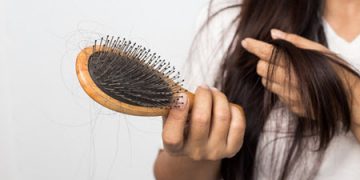

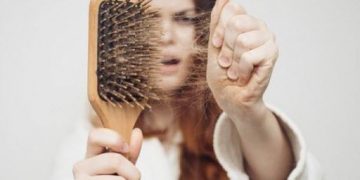
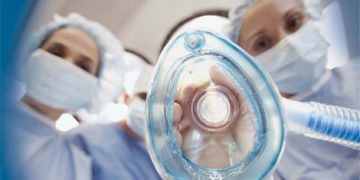














Baldness due to a lot of static electricity.
The source of the static is office supplies from Eric Krause.
With which you do not part.
In the Car, all sensors are on and CheckEjin due to the presence of a fountain pen from EricKrause there.
I knew that because of Eric Krause all the problems.